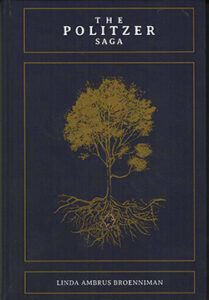The Politzer Saga by Linda Ambrus Broenniman; Glen Echo, Maryland: Bethesda Communications Group; © 2023; ISBN 9781736-777374; 245 pages plus appendices; $38.35 on Amazon for hardcover; free with Kindle unlimited membership.

 SAN DIEGO – Author Linda Ambrus Broenniman knew her parents had immigrated after World War II from Hungary and she thought they were both raised Catholic. She didn’t know that her father, Julian Ambrus, was brought up Jewish, nor that her mother, Clara, risked her life to save Jews during the Holocaust.
SAN DIEGO – Author Linda Ambrus Broenniman knew her parents had immigrated after World War II from Hungary and she thought they were both raised Catholic. She didn’t know that her father, Julian Ambrus, was brought up Jewish, nor that her mother, Clara, risked her life to save Jews during the Holocaust.
Although her father wouldn’t talk about his past, and her mother had slipped into the darkness of Alzheimer’s, a box containing letters, family records, and photographs had been rescued from a house fire and stored away by Linda’s sister, Madeline. That box, including a handwritten notebook titled “Our Family Tree” covered the last six generations of the Politzer family, in which Linda was included.
That set Linda on a search to learn more about her Jewish ancestors – a search in which old friends in the United States and new friends in Hungary assisted her. The result: a fascinating, well-crafted book that takes her family back to the 1700s, a full nine generations before her, to Moses Politzer, a linen merchant about whom Linda has so far uncovered little information except to say that he lived in Bohemia.
Moses’ son Eisik was an itinerant violinist, who played so well a young lady of Croatian ethnicity converted to Judaism so she could marry him – much to the consternation of her father who wanted to have Eisik arrested. The couple fled and went on to have four children, Chave, Gasche, Moricz, and Wolf. Moricz became a medical doctor and for a while he and his wife Rachel lived well, but French soldiers who invaded Hungary stole Morisz’s assets and when he stated to another gang that all his wealth was gone, he was beaten into a coma from which he never recovered.
Morisz’s grandson Zsigmond, who was a successful businessman and banker, wrote Our Family History which added a great deal to Linda’s knowledge about her forebears. Zsigmond had a brother Ádám – they were two of Abraham and Karoline Politzer’s 14 children. Ádám had a most impressive resume: he was an ear, nose and throat doctor – an otolaryngologist –at the dawn of the profession.
Linda writes that “Ádám developed a medical procedure, known as politzerization, to open the Eustachian tube and equalize pressure in the sinuses. He published his findings in 1861, and in 1863 introduced a medical device for performing the procedure, known as the Politzer bag for which he received international acclaim. Throughout his career, he continuously modified and improved the device, and it is still in use today.”
Along with Joseph Gruber, Ádám opened in Vienna the first otology (diseases of the ear) clinic in the world. While Linda was unable to verify a report that he treated the czar of Russia, she and her research colleague András Gyekiczki did find evidence that King Leopold of Belgium was among his patients. He also was honored by Emperor Franz Joseph of Austria Hungary.
Zsigmond’s son Kornél served as a Hungarian diplomat in Belgium, “Hungarianizing” the Politzer family name to Török and converting to Christianity. However, through the Holocaust, most of Zsigmond’s siblings and descendants remained as Jews and Politzers.
While growing up, Linda heard the story of her great-grandmother, the widow Margit Misner Politzer, who lived until 1962. “She ruled the roost,” a friend of the family told her. But when the Nazis occupied Hungary, she became a victim of their depredations. From the wealthy owner of three homes and an estimable art collection, she and her family were forced by Hungary’s version of the Nazi party – the Arrow Cross – to move together into a single room of a “Yellow Star House” as Jewish residences throughout Budapest were labeled. Foreign diplomats, including Swedish envoy Raoul Wallenberg, offered protection to some Hungarian Jews, but Margit hid out instead with one of her relatives who lived in the Buda Hills, and then moved to other hiding places.
“We will never know the details of where, what, and how Margit survived,” Linda wrote. “Once home, her priority was to find her family. It would be several months before Margit could learn their various fates. She lost her father, her brother, and sister, her brother-in-law, her son-in-law and her son-in-law’s brother. Of her relatives on the Politzer side, at least twenty-five aunts, uncles, cousins, nieces and nephews were killed. There were another forty Politzers for whom we don’t have dates of death.”
Margit’s daughter Bözsi was surprised when her son, Julian, a medical student who posed as a Christian in Szeged, married a Catholic classmate, Clara. Bozsi had expected him to marry someone Jewish. Later he formally converted to Christianity, never discussing his Jewish family with Linda.
Perhaps because Julian was so secretive about his Jewish family, Linda’s curiosity about the “forbidden fruit” of her family’s past was aroused. She was a devoted researcher, whose book is a cut above most other family genealogies.
She tells the stories behind her research findings, and she discloses what she doesn’t know, rather than skipping over those details. The book itself is printed on glossy paper, with excellent integration of text and photographs. There are historic sidebars providing the context of three centuries of family history.
*
Donald H. Harrison is publisher and editor of San Diego Jewish World.